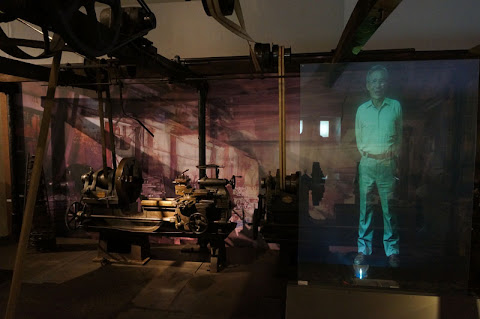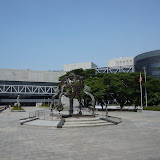What's in travel? Is it arriving, or is it departing? Is it fulfilling dreams, or is it revisiting memories? Or is it just looking for a nice corner to enjoy a cup of coffee?
Thursday, October 06, 2011
The original plan for the day trip was to take the Taroko Express train to visit the Taroko National Park. But it was raining heavily in east Taiwan the entire week, and I decided to change the plan to visit the two National Science Museums. Still, I wanted to experience the Taroko Express, and I decided to take it for a short hop then transfer to the Taiwan High Speed Rail train bound for Taichung.
The second fastest train of Taiwan.

The fastest train of Taiwan.

I had visited the National Museum of Natural Science a couple of times during school trips in my early teens, where there were many hand-on experiments but exhibitions were lacking. The museum has expanded and matured over the years. It now offered rich exhibitions on natural life and evolution, Chinese science and society, and earth and environment. It also had a planetarium and an IMAX theater. I had been to quite a few science museums around the world, and in my opinion, the National Museum of Natural Science could be regarded as a world class museum.
The National Museum of Natural Science had expanded over the years.

If memory served, these moving T-Rex were static displays when I last visited them.

The wooden structure of a temple’s roof hanged over the exhibition hall for Chinese spiritual life.

Delicate miniature models of old Chinese farming village.

Full scale models of Chinese pharmacy selling herb medicines.

Specimens of safari wildlife.

Displays introducing the life circle of stars

Hand-on experiments took the back seat at the museum now.

The green house with a modern glass structure.

Man-made rains kept falling at the rain forests inside the green house.

The museum started from this single building.

Leaving the National Museum of Natural Science, I took the high speed train to Kaoshiung to visit the National Museum of Science and Technology. This was my first time to the museum, which offered many hand-on experiments in introducing food, transportation, weaving, and machinery technologies. The museum did have rich exhibitions on the progress of Taiwan’s telecom and the history of Taiwan’s industries. This museum was not as good as the National Museum of Natural Science but it had a firm foundation and it could only get better.
Students in school trips flooded the museum.

Students took a ride in the earthquake experiencing house.

Students playing simple racing game in a real off-road vehicle.

The fighter jet simulator in the aerospace exhibition hall.

Projected narrator introducing the heavy machineries.

Old hand-crank telephones that required operators.

Evolution of Taiwan’s toll phones.

People used to gather in front of televisions to watch live national baseball games and cheer for the local teams at late night.

Taiwan’s computer industry had evolved from making clones to established brands.

Taiwan’s bicycle industry had also made its name in the world.

The water clocks of the two National Science Museums.

After visited the two museums, I caught another high speed train to go back to Taipei. Looking at the scenery of west Taiwan while checking my location on the smart phone, the time passed like fly.
Sunset over rice farms of west Taiwan.

Photo Albums
The second fastest train of Taiwan.

The fastest train of Taiwan.

I had visited the National Museum of Natural Science a couple of times during school trips in my early teens, where there were many hand-on experiments but exhibitions were lacking. The museum has expanded and matured over the years. It now offered rich exhibitions on natural life and evolution, Chinese science and society, and earth and environment. It also had a planetarium and an IMAX theater. I had been to quite a few science museums around the world, and in my opinion, the National Museum of Natural Science could be regarded as a world class museum.
The National Museum of Natural Science had expanded over the years.

If memory served, these moving T-Rex were static displays when I last visited them.

The wooden structure of a temple’s roof hanged over the exhibition hall for Chinese spiritual life.

Delicate miniature models of old Chinese farming village.

Full scale models of Chinese pharmacy selling herb medicines.

Specimens of safari wildlife.

Displays introducing the life circle of stars

Hand-on experiments took the back seat at the museum now.

The green house with a modern glass structure.

Man-made rains kept falling at the rain forests inside the green house.

The museum started from this single building.

Leaving the National Museum of Natural Science, I took the high speed train to Kaoshiung to visit the National Museum of Science and Technology. This was my first time to the museum, which offered many hand-on experiments in introducing food, transportation, weaving, and machinery technologies. The museum did have rich exhibitions on the progress of Taiwan’s telecom and the history of Taiwan’s industries. This museum was not as good as the National Museum of Natural Science but it had a firm foundation and it could only get better.
Students in school trips flooded the museum.

Students took a ride in the earthquake experiencing house.

Students playing simple racing game in a real off-road vehicle.

The fighter jet simulator in the aerospace exhibition hall.

Projected narrator introducing the heavy machineries.

Old hand-crank telephones that required operators.

Evolution of Taiwan’s toll phones.

People used to gather in front of televisions to watch live national baseball games and cheer for the local teams at late night.

Taiwan’s computer industry had evolved from making clones to established brands.

Taiwan’s bicycle industry had also made its name in the world.

The water clocks of the two National Science Museums.

After visited the two museums, I caught another high speed train to go back to Taipei. Looking at the scenery of west Taiwan while checking my location on the smart phone, the time passed like fly.
Sunset over rice farms of west Taiwan.

Saturday, October 01, 2011
We came to Wanhua on this Saturday afternoon. Wanhua was one of the oldest district of Taipei city, but even though we passed through it all the time, it’s been some time since we really visited places here. Unfortunately, it was raining during our visit.
We came to the Wanhua sugar warehouse culture park. There are four warehouses in the park and it was managed by the Taiwanese Opera company Ming Hwa Yuan.
The trains used to transport sugars now parked in front of the warehouses.

This red brick warehouse was used to exhibition the history of the sugar industry of Taiwan.

The exhibitions described the progress of sugar processing technologies.

A model of modern sugar processing plant.

Artifacts used during the operations of the sugar trains.

These two warehouses was used for exhibitions of the costumes, props, and sets used in the stage performance of Ming Hwa Yuan.

Photographs were not allowed for the exhibitions of Ming Hwa Yuan, except this three-head dragon outside the set factory.

We next went to the Longshan Temple frequented by worshipers and tourists.

Our last stop was the Bo-Pi Liao historical site. The buildings and storehouses were well preserved here, but most of the houses remained empty.

The clean and quite alley of Bo-Pi Liao.

Modern structures were added to some of the buildings. I could understand the steel beams were added for structure integrity, but I was quite confounded by the glasses rooms and the walkways.

Only a handful houses in the historical site were used for exhibitions and all the other buildings were kept empty and locked out.

Photo Album
We came to the Wanhua sugar warehouse culture park. There are four warehouses in the park and it was managed by the Taiwanese Opera company Ming Hwa Yuan.
The trains used to transport sugars now parked in front of the warehouses.

This red brick warehouse was used to exhibition the history of the sugar industry of Taiwan.

The exhibitions described the progress of sugar processing technologies.

A model of modern sugar processing plant.

Artifacts used during the operations of the sugar trains.

These two warehouses was used for exhibitions of the costumes, props, and sets used in the stage performance of Ming Hwa Yuan.

Photographs were not allowed for the exhibitions of Ming Hwa Yuan, except this three-head dragon outside the set factory.

We next went to the Longshan Temple frequented by worshipers and tourists.

Our last stop was the Bo-Pi Liao historical site. The buildings and storehouses were well preserved here, but most of the houses remained empty.

The clean and quite alley of Bo-Pi Liao.

Modern structures were added to some of the buildings. I could understand the steel beams were added for structure integrity, but I was quite confounded by the glasses rooms and the walkways.

Only a handful houses in the historical site were used for exhibitions and all the other buildings were kept empty and locked out.

Subscribe to:
Comments (Atom)


